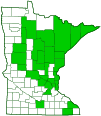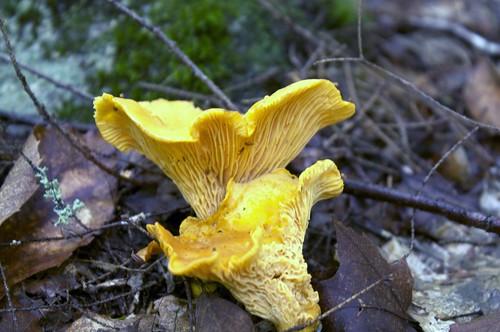Golden Chanterelle
(Cantharellus cibarius group)
Conservation • Description • Habitat • Ecology • Distribution • Taxonomy
Conservation Status |
|
|||||||
| IUCN Red List | not listed |
|||||||
| NatureServe | not listed |
|||||||
| Minnesota | not listed |
|||||||
Description |
||
Golden Chanterelle is a small to medium-large edible mushroom with a long growing season. It grows on the ground and is usually solitary. The stalk is The cap is The flesh is whitish except beneath the skin of the cap, where it is tinged yellow to orange. Cantharellales do not have true gills. The spore-bearing surface on the underside of the cap is deeply wrinkled and gill-like. The “gills” are closely spaced to well-spaced and the same color as the cap though paler. They are forked near the end (toward the margin of the cap) into two branches. They are shallow and the edges are thick and blunt, appearing as if “melted”. They extend down along the stalk (decurrent). The spore print is usually creamy or yellow, sometimes pinkish. |
||
Similar Species |
||
Jack-o’-Lantern Mushroom (Omphalotus illudens) is usually found in groups. The stalks of grouped mushrooms are connected at the base. The gills are not forked. They are deep and the edges are sharp, like the edge of a knife. It is poisonous. |
||
Habitat and Hosts |
||
Woods |
||
Ecology |
||
Season |
||
Spring to fall |
||
Distribution |
||||
|
Sources |
|||
| 6/6/2022 | ||||
Occurrence |
||||
Common and widespread |
||||
Taxonomy |
|||
| Kingdom | Fungi (fungi) | ||
| Subkingdom | Dikarya | ||
| Phylum | Basidiomycota (club fungi) | ||
| Subphylum | Agaricomycotina (jelly fungi, yeasts, and mushrooms) | ||
| Class | Agaricomycetes (mushrooms, bracket fungi, puffballs, and allies) | ||
Order |
Cantharellales | ||
Family |
Cantharellaceae | ||
Genus |
Cantharellus (chanterelles) | ||
Synonyms |
|||
|
|||
Common Names |
|||
Chanterelle Golden Chanterelle |
|||
Glossary
Universal veil
An egg-like structure that envelopes all or most of a developing gill mushroom. Remnants of the universal veil sometimes visible on a mature mushroom are patchy warts on the cap, a ring on the stalk, and a volva at the base of the stalk.
Volva
Also called cup. A cup-like covering at the base of a mushroom stem, sometimes buried. It is the remnants of the universal veil ruptured by the mushroom pushing through. It is found on Amanita, Volvariella, and some other mushrooms.
Say “Goodbye” to an old friend and “Hello” to a new group
Until very recently, yellow to yellowish-orange chanterelles in North American hardwood forests were all treated as a single, easily identified species, Golden Chanterelle (Cantharellus cibarius). Recent DNA analysis shows that the North American chanterelles are a group of closely related species now known as the Cantharellus cibarius group. The type species of the group, Cantharellus cibarius, is restricted to Europe and does not occur in North America. To date (2022), several new species have been defined, four of them occurring only west of the Rocky Mountains. More species east of the Rockies will almost certainly be described in the coming years.
Visitor Photos |
|||||
Share your photo of this fungus. |
|||||
| This button not working for you? Simply email us at info@MinnesotaSeasons.com. Attach one or more photos and, if you like, a caption. |
|||||
Beulah Morrison |
|||||
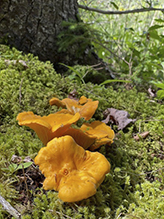 |
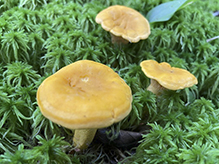 |
||||
Cadillacs of the woods |
|||||
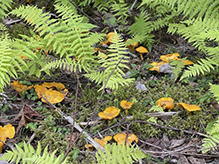 |
|||||
Luciearl |
|||||
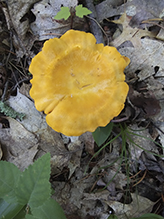 |
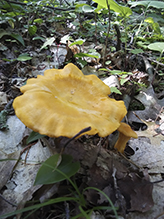 |
||||
Jeffrey M. Arsenault |
|||||
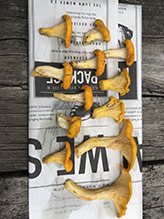 |
|||||
Matthew Bourman |
|||||
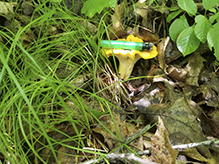 |
|||||
Stephanie Segner |
|||||
August 2017 |
|||||
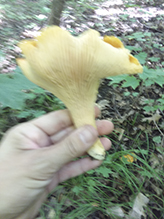 |
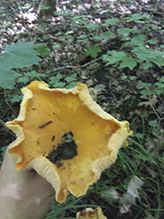 |
||||
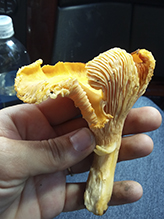 |
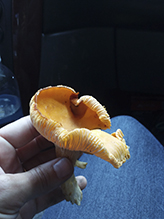 |
||||
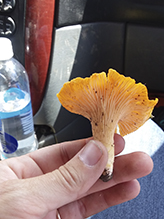 |
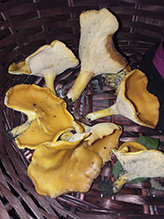 |
||||
MinnesotaSeasons.com Photos |
|||||
Mushroom |
|||||
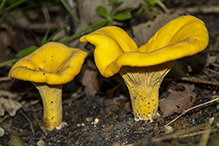 |
|||||
Cap |
|||||
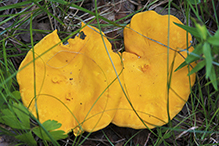 |
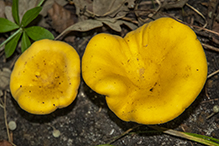 |
||||
Gills |
|||||
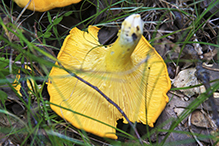 |
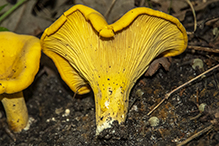 |
||||


Visitor Videos |
|||
Share your video of this fungus. |
|||
| This button not working for you? Simply email us at info@MinnesotaSeasons.com. Attach a video, a YouTube link, or a cloud storage link. |
|||
Other Videos |
|||
| The Mikeology Store on the Hunt for Chanterelle Mushrooms Mike Kempenich |
|||
About
Uploaded on Jul 29, 2011 A morning hunting wild Chanterelle mushrooms in Minnesota. |
|||
| Chanterelle Look Alikes - Toxic Jack O' Lantern Mushroom Identification Chanterelle Look Alikes - Toxic Jack O' Lantern Mushroom Identification |
|||
About
Published on Aug 17, 2013 Chanterelle look alikes. Toxic jack o' lantern mushroom identification. The jack o' lantern mushroom, Omphalotus illudens or Omphalotus illudens, may be confused with edible chanterelle mushrooms, but the color of the flesh and gills are a dead giveaway that the two fungi are completely different. Jack o' lanterns are saprobic meaning they grow from wood, whereas chanterelles are not saprobes. But, as you can see in this video the jack o' lanterns appear to be growing from the ground not wood. I find many jack o' lantern mushrooms growing in open lawns and I find chanterelles that appear to be growing from wood. These habitat and growth characteristics are listed in most field guides and mushroom identification books, but, they are not nearly as reliable as paying close attention to the gills and color of the flesh, i.e. the physical features of the fungi in question. Paying close attention to physical features of mushrooms is critically important in order to get a positive identification. As long as one pays close attention to the physical characteristics of fungi, most of the common and abundant gourmet edible fungi can be easily and safely identified for the table. Jack O' Lantern mushrooms have been reported to glow in the dark, a bioluminescent fungi. To see mushroom, plant, garden and outdoor photos, field guides I use, plant and mushroom identification books, and other interesting stuff visit me on Facebook www.facebook.com/michigan.wilderness Thanks for watching, commenting, subscribing to, and supporting this channel. If you like this video please give a thumbs up and share it with others. If you have any questions or tips please leave a comment. |
|||
| Chanterelle Harvesting Tips | Harmonic Arts Harmonic Arts Botanical Dispensary |
|||
About
Harmonic Arts Botanical Dispensary Tips and tricks from Master Herbalist Yarrow Willard of Harmonic Arts on harvesting wild chanterelles in the forests of the Pacific North West. Harmonic Arts Website Instagram Facebook Pinterest Twitter |
|||
| How to find Wild Chanterelle Mushrooms, aka Cantharellus Cibarius Good Earth Spa |
|||
About
Uploaded on Oct 5, 2010 I am on a mushroom hunt in the Pacific Northwest and I find some Chantrelle mushrooms growing wild. Actually, as far as I know they only grow wild and no one has been able to cultivate them. Enjoy. Pics at the end! |
|||
| Summer Mushroom Foraging - Golden Chanterelle Cinnabar Chanterelle And Chanterelle Look Alikes MiWilderness |
|||
About
Published on Aug 3, 2013 Summer mushroom foraging for golden chanterelle, cinnabar chanterelle and chanterelle look alikes. Edible chanterelle mushrooms are fairly easy to identify as long as you pay attention to the features such as false gills that fork out toward the cap margin and white inner flesh that is continuous, solid and unchanging between the stalk and cap. Golden chanterelles have a unique smell which may help identify them. Paying close attention to physical features of edible mushrooms helps distinguish them from potentially toxic look alike fungi such as Jack O' Lanterns, Omphalotus illudens. The scientific name for golden chanterelle is Cantharellus cibarius. the scientific name for cinnabar chanterelle is Cantharellus cinnabarinus. Chanterelle mushrooms are found in hardwood forests of the eastern woodlands from early summer through autumn. Chanterelles are foraged throughout the world. Chanterelles are wild edible gourmet mushrooms. Wild edible fungi can be found at restaurants, organic food markets, and farmer's markets throughout the world. Chanterelles and other wild edible gourmet mushrooms can be foraged for free in the backyard or local woodland. More mushroom foraging videos: http://www.youtube.com/playlist?list=PL122A6E3339A70090 Shrub and tree identification videos: http://www.youtube.com/playlist?list=PL69BBBB171107F34B Wild plant foraging and plant identification http://www.youtube.com/playlist?list=PLAB9DFB2A4ED09C68 Wilderness medicine, folk medicine, and herbal http://www.youtube.com/playlist?list=PL81021CE944A71DDF www.facebook.com/michigan.wilderness Thanks for watching, commenting, subscribing to, and supporting this channel. If you like this video please give a thumbs up and share it with others. If you have any questions or tips please leave a comment. |
|||


Last Updated:
